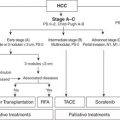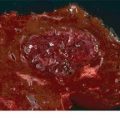Most studies indicate that a Roux-en-Y hepaticojejunostomy is the safest and most reproducible method of biliary–enteric reconstruction possessing the best long-term patency rate. The critical skill set for this procedure is intracorporeal suturing using laparoscopic needle drivers and graspers. The following are the critical steps toward biliary–enteric reconstruction:
1.Patient position with both arms out is suitable.
2.Port placement can vary among surgeons, but Figure 28.1 demonstrates an accepted configuration. The ports consist of a 5 mm port in both the right and left subcostal margins, a 12-mm right upper quadrant port (surgeon’s primary port), and a 5- or 12-mm port in both the left upper quadrant and umbilicus (primarily for the camera). A subxiphoid incision can be made without a port for placement of a liver retractor.
3.To create the Roux limb, starting in the supine position is best. The ligament of Treitz is identified at the base of the transverse mesocolon.
4.A window is created between the vasa recta of the small bowel, and the small bowel is divided using a laparoscopic stapler with a 3.5-mm staple load approximately 50 cm distal to the ligament of Treitz.
5.Use the tissue-sealing device to divide the mesentery evenly in order not to encroach on the arterial arcade on either side of the divided bowel (optional). This maneuver provides a slightly longer reach to the bile duct and avoids undue tension on the anastomosis. The bowel proximal to the staple line is the alimentary limb; an additional 50 cm of small bowel distal to the staple line is measured and referred to as the Roux limb.
6.A side-to-side jejunojejunostomy is fashioned:
a.Two 3-0 absorbable stay sutures are placed 6 to 10 cm apart.
b.Enterotomies are created with the cautery.
c.An articulating 60-mm cartridge of a 2.5-mm staple load is introduced into the bowel via the enterotomies. This load is generally more hemostatic than is the typical 3.5-mm load used commonly for bowel cases.
d.The bowel is manipulated so that the mesentery is outside the staple load.
e.The anastomosis between the alimentary and Roux limbs is created with the stapler.
f.The common enterostomy is oversewed with a 3-0 absorbable running suture.
g.The jejunojejunostomy mesenteric defect is closed with a running 2-0 nonabsorbable suture to prevent future internal hernias. Avoid full-thickness bites across the bowel mesenteric edge that was previously sealed with an energy device, which can lead to unnecessary hemorrhage, ischemia, or hematoma near the anastomosis. The subsequent complications include bleeding, perforation, and obstruction postoperatively. Solely suture the peritoneum superficially together.
h.Visualize the Roux limb mesenteric edge, and travel down toward the root of the mesentery to ensure the mesentery is not twisted (this is worth double or triple checking as peripheral visualization is limited during laparoscopic surgery).
i.Create a defect in the transverse mesocolon with the tissue-sealing device to the right of the middle colic artery. Preserve the left space in case a future pancreatic Roux limb is needed.
j.Mark the Roux limb staple line with a stitch or a Penrose drain/colored tourniquet to make passing the bowel through the transverse mesocolon defect easier (optional).
7.Mobilization of the common bile duct within the hepatoduodenal ligament—mobilizing the hepatic flexure of the colon and performing wide Kocher maneuver should be used liberally to expose the porta hepatis:
a.If no cholecystectomy has been performed previously, use the gallbladder to identify the cystic duct, and travel proximally toward the common hepatic–bile duct junction. The gallbladder also provides a useful “handle” (Fig. 28.2) for a lateral to medial approach when dissecting the soft tissues of the hepatoduodenal ligament. Typically, there is a station 12 lymph node just cephalad to the duodenum along the lateral border of the ligament to mark the location of the distal common bile duct.
b.Incise the peritoneum anteriorly to expose the bile duct and hepatic arterial supply. The bile duct will be lateral to the proper hepatic artery. Be mindful that the right hepatic artery travels anterior to the common hepatic duct in 10% of patients.
c.Mobilize the ligament further by incising the peritoneum laterally toward the inferior vena cava to open near the shared border of the common bile duct and portal vein. This maneuver will allow for less resistance when dissecting medially to laterally posterior to the bile duct.
d.Encircle the bile duct with a vessel loop or Penrose drain; use metallic clips to secure both tails together for retraction purposes.
e.Pass a right-angled instrument posterior to the bile duct, and use the cautery to divide the bile duct. The cautery can be used to obtain hemostasis at the 3 and 9 o’clock arterial supple at the cut edge of the bile duct. The bile duct should bleed briskly; if it does not, then consider dissecting the bile duct proximally to better perfused tissue.
f.If a biliary endoprosthesis or percutaneous biliary drain is across the bile duct, either can be used to stent your anastomosis. Otherwise, if it is cumbersome, stents can be removed as it may make the anastomosis more difficult. If stenting the biliary–enteric anastomosis is desired, the ideal situation is to place your own 12-Fr biliary stent across the anastomosis after the posterior row has been completed.
g.A laparoscopic bulldog clamp is commercially available and can be used to clamp the proximal cut edge of the bile duct; in some cases, this may allow for a slight dilatation of a smaller bile duct and minimize biliary soilage of the peritoneum.
h.The distal bile duct should be oversewn or may be closed with a staple (or clips if small).
6.Biliary–enteric anastomosis:
a.
Stay updated, free articles. Join our Telegram channel

Full access? Get Clinical Tree







